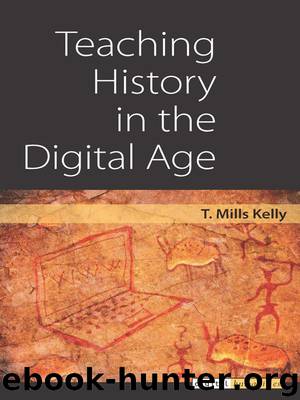Teaching History in the Digital Age by T. Mills Kelly

Author:T. Mills Kelly
Language: eng
Format: epub
Publisher: The University of Michigan Press
Published: 2018-05-15T00:00:00+00:00
While Gaffield, currently the president of Canada's Social Science and Humanities Research Council, is describing the history classes he experienced as a young student in the 1960s, it is not an exaggeration to say that historical methods is still largely taught this same way on most college campuses.
In an attempt to break away from this style of teaching the methods course and to give my students a chance to “play the sport” of history, I created a new version of the old methods course and called it “Dead in Virginia.” In creating this new course I took advantage of several opportunities available to my students near my university—George Mason University—located in Fairfax County, Virginia. In Fairfax County, there are more than 400 family cemeteries, and in the surrounding region the number probably approaches 1,000. These cemeteries range in size from a single headstone or marker, to large plots with a few dozen graves. They are in various states of repair or disrepair, and some are more accessible than others: some were within walking distance of campus, others were much farther away; some were located on public lands; others were on private Page 87 →property, but all of them were available for my students as sites of research. In addition to this physical landscape of the past, the local public library's Virginia Room contains vertical files on all of the known family cemeteries in Fairfax County, giving my students access to a real historical archive within walking distance of our campus. Finally, my students were able to connect with representatives of a local historical society—the Fairfax County Cemetery Preservation Association—and so learned the value of the work being done by historians outside the academy.16 One of the best lessons they learned was that the members of the association had very detailed knowledge of local history, but did not always have equally detailed knowledge of the broader historiography of eighteenth-, nineteenth-, or twentieth-century America.
To complete their work, the students in my class had to select one of the family cemeteries in our local area, go to it, and learn everything they could learn at the site itself—geographic location, orientation, size, condition, number of headstones, number of depressions that might indicate the presence of a grave, information inscribed on the headstones, and so on. While there they had to draw an accurate map of the site and photograph it, along with each of the headstones. Once they had gathered all the information they could at the site, they had to go to the local library and begin their archival research on the cemetery and the people buried there (or suspected to be buried there). Following their archival research, they then turned to online genealogical resources such as Ancestry.com and other primary sources (online and analog) such as newspapers from the time when the people buried in their cemeteries were alive, property and trial records at the local courthouse, and other similar archival sources. Many of the students also tracked down descendants of those
Download
This site does not store any files on its server. We only index and link to content provided by other sites. Please contact the content providers to delete copyright contents if any and email us, we'll remove relevant links or contents immediately.
Navigation and Map Reading by K Andrew(5111)
Spare by Prince Harry The Duke of Sussex(5078)
Tuesdays with Morrie by Mitch Albom(4696)
Cracking the GRE Premium Edition with 6 Practice Tests, 2015 (Graduate School Test Preparation) by Princeton Review(4227)
Machine Learning at Scale with H2O by Gregory Keys | David Whiting(4199)
Never by Ken Follett(3800)
Goodbye Paradise(3730)
What It Really Takes to Get Into Ivy League and Other Highly Selective Colleges by Hughes Chuck(3697)
Harry Potter and the Prisoner of Azkaban (Book 3) by J. K. Rowling(3304)
Fairy Tale by Stephen King(3227)
Pledged by Alexandra Robbins(3138)
Kick Ass in College: Highest Rated "How to Study in College" Book | 77 Ninja Study Skills Tips and Career Strategies | Motivational for College Students: A Guerrilla Guide to College Success by Fox Gunnar(3077)
A Dictionary of Sociology by Unknown(3032)
Sapiens and Homo Deus by Yuval Noah Harari(2990)
Reminders of Him: A Novel by Colleen Hoover(2952)
The Social Psychology of Inequality by Unknown(2941)
Graduate Admissions Essays, Fourth Edition: Write Your Way into the Graduate School of Your Choice (Graduate Admissions Essays: Write Your Way Into the) by Asher Donald(2878)
Will by Will Smith(2795)
Zero to Make by David Lang(2727)
